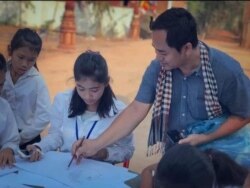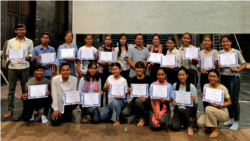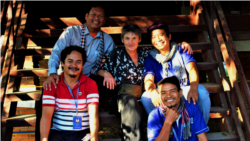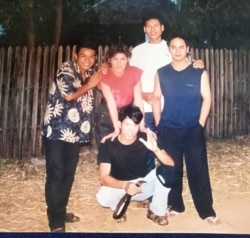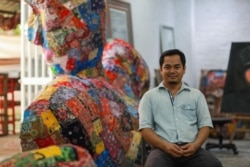Hor Seyha remembers shadowing Srey Bandaul from school to school in Siem Reap, painting colorful pictures on the buildings’ walls. Hor Seyha was inspired and, in 2005, Srey Bandaul started training him to draw and paint – skills that not only helped him earn a living but also molded him as an artist.
“He explained to me the benefits of painting. He said that in the world, the field of painting is widely recognized,” Hor Seyha said.
“Everything we see, such as houses, models, cars, or anything, is developed from the scratch of paintings. Since then, I have embraced this as a meaningful career.”
Srey Bandaul is the co-founder of Phare Ponleu Selapak, an arts organization based in Battambang province. The 49-year-old artist was hospitalized with COVID-19 last week and died on August 4 at a treatment facility in Battambang city. Srey Bandaul is survived by his wife and two daughters.
The influential artist’s legacy, his friends and family said, was his ability to nurture and mentor talented individuals – many of whom came from at-risk or vulnerable communities – by giving them a safe haven at the art school.
Hor Seyha is a good example of Srey Bandaul’s influence on the Cambodian art landscape. Hor Seyha, 30, is now a professional painter at the Romchiek 5 Artspace in Battambang, but only after Bandaul offered him a part-time job painting murals at schools in 2007.
“When I made a mistake, I was afraid he would blame me. It turns out when we met, he tapped on my shoulder and talked with me, and encouraged me,” Hor Seyha said.
A press release from Phare Ponleu Selapak points to Srey Bandaul’s impressive career. He had his work exhibited in many countries, including Turkey, the United Kingdom, the Philippines, Thailand, Myanmar and Australia, and authored two books as well.
Khuon Deth, a co-founder of Phare Ponleu Selapak, had a front row seat to Srey Bandaul accomplishments.
“We had been together since we were little. There were so many precious memories,” Khuon Deth said.
"As we grew up, we nurtured and took care of each other," he added. “In our personal life, we gave each other advice. We always shared our thoughts and visions on how to grow Phare’s future.”
Srey Bandaul has always pointed to his drawing teacher, Veronique Decrop, as a guiding force in his early development as an artist. They first met at a refugee camp in Thailand, where thousands had fled to escape the Khmer Rouge’s murderous regime.
“This death takes me back to other deaths within our founding team and I feel crushed,” she said on Wednesday. “Bandol was not old enough to die and he still had so much to do and give, to his family, to his little girls and also to us, to Phare.”
After returning to Cambodia in 1994, Srey Bandaul and a few friends decided to start Phare Ponleu Selapak to restore the country’s art culture but also create a Cambodian identity through its art.
But Srey Bandaul wasn’t blinkered by a focus on the arts, but also on how it could reduce trauma faced by Cambodians.
“We wanted to help others who experienced trauma the same way— by using arts to heal them. Bandaul always said that ‘Phare means the light— to give hope to other people’s lives',” Khuon Deth said.
Sao Sreymao is a Cambodian independent artist who met Srey Bandaul as a teenager. He showed her the beauty of art, Sreymao said, and how it can help solve life’s struggles. This helped the teen who had lost family members, dropped out of school and had run away from her home.
“And, to change my [negative] thoughts, he urged me to go to the library and read books. For someone who had lost themselves at such a young age, his presence was just so important for our growth,” Sao Sreymao said.
Bandaul’s parents – Srey Sopheap, 74, and Seurn Saroeun, 70— were stricken with grief when VOA Khmer spoke to them last week.
They said the family was at Site II refugee camp along the Cambodia-Thailand border in the late 1970s, where Bandaul’s father was a soldier and his mother was a photograph printer. They said, as the eldest son in the family, Srey Bandaul used his art and storytelling talents to help his parents earn extra money to feed his five sisters and two brothers.
Asked about their son’s impressive career and life, all they could say through the grief was that they were “very proud of our son.”





